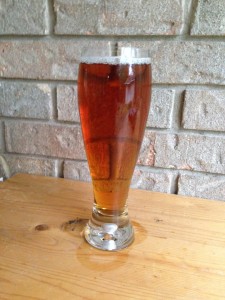This is the recipe for my copper ale. The name is simply a reference to the the color of the beer. I designed this beer to be an “everyday” beer that I would enjoy, and other people who have tried it have really liked it. I’ve brewed it eight or nine times now, and everytime I’ve mucked with the recipe a little bit. But, it’s always hovered around the same basic idea.
I started with a blank canvas, so to speak. I didn’t start with an existing beer style and tweak the beer from there. Instead, I just thought of one combination of ingredients that I believed would go well together and started brewing. The grain bill started with pale malt blended with Munich malt, for a solid, malty base. A little bit of aromatic malt and Victory malt round out the malt character. (In previous versions of this recipe, Victory malt was the only (non-color) specialty malt, but I like the addition of aromatic malt.) I didn’t add any crystal malt — mostly because I wanted the beer to finish fairly dry, but secondarily because so many homebrew recipes contain crystal malt that I wanted to try something different. The color is tweaked by adding a small amount of roasted malts, chocolate and black malt. These add color, but there isn’t any roast flavor in the beer to speak of.
The beer’s malt character is offset by bitterness from Northern Brewer hops. These hops lend a faint mint-like character to the beer. In my most recent versions of this recipe, I added some Fuggles finishing hops, for that nice, “earthy” Fuggles character. The American ale yeast strain ferments cleanly and really lets the malt and hop character take center stage. The beer finishes around FG 1.010, so it’s relatively dry, which I think highlights the malty/biscuit-like/”husk-y grain-y” malt character of the beer. (In my next version of this, I might try adding some wheat malt, for some bread-like notes. This is my only recipe that has gotten more complex over time. I may also split batch it and try some English or Belgian yeast strain.)
I started thinking about the beer without any reference to existing beer styles, so it’s not surprising that it doesn’t really mimic any classic beer style. It fits the numbers of an altbier (BJCP category 7A) fairly well, but doesn’t really taste like an alt. Overall, it’s just a great “everyday” beer — balanced and drinkable, but with enough flavor to be still be interesting.


Recent Comments